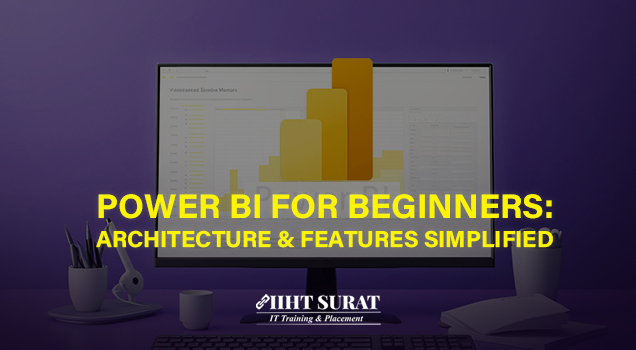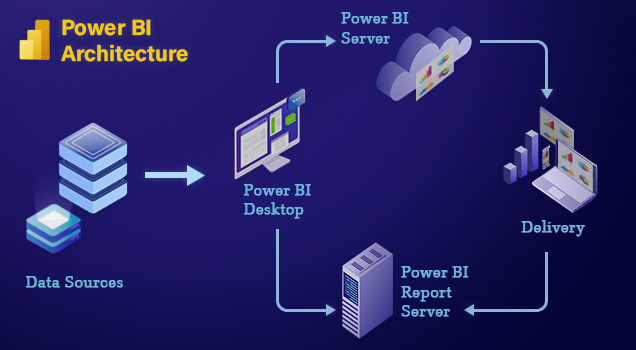Power BI for Beginners : Architecture & Features Simplified

Table of Contents
ToggleColumns or Charts!!!
If you were asked to choose between data filled with Columns and data represented through Charts, which would you choose for easy data analysis? If not wrong, Obviously Charts would be your preference.
However, Creating Charts from piles of data is more challenging than it seems to be. But with the Business Intelligence Power BI, it is possible.
Are you keen to know about this exciting tool? Well, read out the entire piece of content to know more about this Business Intelligence Power BI Tool. Before Understanding this tool, let’s understand the importance of data visualization and analysis in modern business scenarios.
Data is the Backbone of every organization, without its proper care and visualization, an organization can’t grow and compete in the current competitive world. It’s not the data that matters but its representation & visualization too.
Businesses need data visualization to help them quickly detect data trends. The Pictorial Representation of Data enables the Data Analysts to understand the new statistics in one go. Moreover, Data visualization is essential in the modern Data-Driven World. With a surge in the collection of data, Data Visualisation and Analysis have become an important factor for all the Business & Industries.
Why is Data Visualization Important? Let’s have a quick recap of its importance
- Analyzing Data More Effectively : Analyzing reports allows business stakeholders to focus on the areas that need attention. Visual data assists analysts in understanding the main elements necessary for their business. A visual depiction of data, whether in the form of a sales report or a marketing strategy, assists businesses in increasing profits through better analysis and decision-making.
- Enhances Decision-Making : Visuals are easily referred to and understood as compared to complicated tabular data formats. When data is visually sound to read, it increases the decision-making process among the decision-makers and in turn leads to the growth of the business.
- Organizing Complicated Information : Business houses can obtain visual insights from their bulk data with the help of Data visualization tools. Error from the data can be easily identified and rectified through charts and graphs. Understanding these patterns enables users to focus on regions that signal progress or warning signs. The business then advances as a result of this procedure.
Introduction to Business Intelligence Power BI
Microsoft’s Power Business Intelligence (BI) is a set of software services and applications that work together to analyze and visualize data sources into visually represented charts and graphs. It is a technologically driven business Intelligence tool that provides data analysis, and visually sound insights which in turn helps the organization to make data-driven business decisions. Whether you have your data in an Excel sheet or stored in a cloud-based data warehouse, with the help of Power BI, you can integrate your multiple data sources at a place and arrange it into visually impressive data analysis to share with anyone or everyone.
Since we are clear with the concept of Business Intelligence Power BI, Let’s understand what are the different versions of Power and how data flows through it.
Microsoft’s Power BI supports a wide range of data sources. Power BI Desktop enables you to generate reports and data visualizations from the dataset. Power BI gateway connects to on-premise data sources to provide continuous data for reporting and analytics. Power BI services are cloud-based services that enable the publication of Power BI reports and data visualizations. Using Power BI mobile apps, you may access their data from anywhere. Power BI apps are available on the Windows, iOS, and Android platforms.
These three components—Power BI Desktop, the service, and the mobile apps—are intended to enable you to produce, distribute, and consume business insights in the most efficient manner for your organization.
The MS Business Intelligence Power BI architecture is structured into four main steps that outline the complete process, from data collection to reporting and dashboard creation. Various technologies and procedures work together to get the necessary results with high precision. Let us take those steps farther. Visit here to learn Business Intelligence With a Power BI course in Surat

Sourcing Information
Microsoft’s Power BI collects information from a variety of servers, Excel sheets, CSV files, and databases. The extracted data can be directly imported into Power BI, or a live service link is created to receive it. If you import the data directly into Power BI, it will be compressed up to 1 GB. Following that, you can only perform live queries on your bulky datasets.
Data Transformation
Data transformation involves cleaning and preprocessing before visualization. This entails deleting superfluous or missing values from rows and columns. After that, specific rules will be used to transform and load the datasets into the warehouse.
Reporting and publishing
After the data has been cleaned and transformed, reports will be generated based on the requirements. A report is a visual representation of data with various filters and limitations shown as graphs, pie charts, and other figures.
Building dashboards
Microsoft Power BI Dashboards are built by pinning individual elements or pages from live reports. Dashboards should be built when your reports have been uploaded to the BI service. When the reports are saved, the visual retains the filter settings so that the user can use filters and slicers.
Key Features of Power BI
I. Wide Data connectivity options – Power Business Intelligence (BI) is designed to integrate with multiple data sources, which allows the users to import data from multiple database sources. Due to the wide data connectivity, it acts as a connector between all the sources of data and provides visually sound data in the graphical representation.
II. Data transformation and modeling capabilities – Power Business Intelligence (BI) is equipped with data transformation and modeling capabilities, through which users can organise, modify and convert raw data into an insightful graphical representation. Because of these capabilities, it is used for processing & analyzing messy, detailed & interconnected data in one go.
III. Interactive visualizations and reports – By generating interactive visuals and reports, it has eased off the workload of many data analysts. It is capable enough to interpret the data in the most effective and efficient manner by providing visual representations.
IV. Power Query, Power Pivot, and DAX language – Microsoft Power BI is the best business analytics solution that includes several tools to help edit and view data. The combination of Power Query, Power Pivot, and the DAX (Data analytical Expressions) language broadens Power BI’s data processing and analytical capabilities.
Benefits of Using Power BI
I. Improved decision-making through data insights.
Accumulating data isn’t enough, its analysis and visualization are equally important to give valuable insights. Power BI provides accurate data visualization which leads to improved, timely, and effective decision-making.
II. Time and cost savings in data analysis.
When Microsft Power BI is integrated with the Data sources it provides quality and real-time data report and analysis which in turn leads to time & cost savings as new data stored need not need to be analyzed separately, with Power BI data is updated into insightful visual charts & graphs.
III. Increased collaboration and data sharing across teams.
Power BI is equipped with a Sharing & collaboration feature, which helps multiple users within organisation to share their reports and collaborate on particular projects with great ease.
Advanced Tips and Tricks for Power BI for Beginners
I. Using custom visuals to enhance reports.
Many Kinds of Visuals can be generated through Power BI, but is important to customize your visual based on your data type. For Example, While analyzing proportional values – Make use of Pie or Donut Charts, While comparing two data – use a Column or bar Chart.
II. Power BI best practices for efficient data modeling.
Data modeling is the blueprint of the command that is being given to the Power BI algorithm to access data and process insightful reports through visual representation. Learn Power BI Best practices for efficient data modeling with us.
- Begin with clean and well-structured data using power query to transform your raw data into the right format.
- Make clear relationships between tables. Use Bi-directional filtering instead of circular relationships
- Create Hierarchies to give more details insights of your data
- Reduce the data model size by removing unused tables & columns.
Conclusion
From the above piece of knowledge, it is very clear that Microsoft Power BI is the most useful & data-driven tool that converts raw data into insightful visuals. Its features, importance, models, benefits, and its components make it a complete solution for organizations looking to maximize the value of their data for informed decision-making and strategic planning. Business Intelligence Power BI Powerful analytics tools and its seamless integration across multiple data sources enable the organization to get the best result of the quality of its data in real-time, ensuring that business houses stays up to date with their data in this ever-changing & data-driven business landscape.
Data and its analysis is the need of the hour and if you are also looking forward to learning in-depth about this powerful data-driven tool then Learn Power BI with IIHT Power BI Certification Training Course in Surat which covers the entire concept and working of Business Intelligence Power BI from its introduction to tips & tricks to use its effectively.
